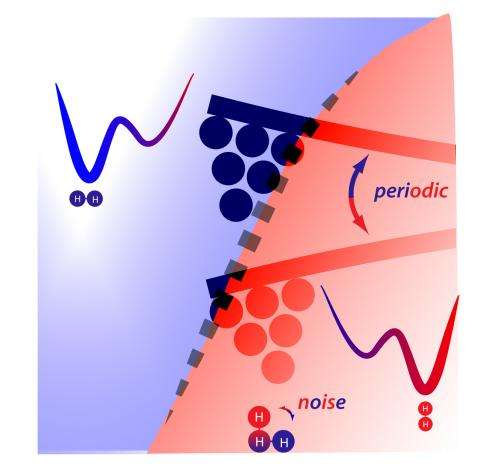Transforming noise into mechanical energy at nano level

A team of researchers at the Freie Universität Berlin, co-ordinated by José Ignacio Pascual, have developed a method that enables efficiently using the random movement of a molecule in order to make a macroscopic-scale lever oscillate. The research was published in Science.
In nature processes such as the movement of fluids, the intensity of electromagnetic signals, chemical compositions, etc., are subject to random fluctuations which normally are called 'noise'. This noise is a source of energy and its utilisation for undertaking a task is a paradigm that nature has shown to be possible in certain cases.
The research led by José Ignacio Pascual and published in Science, focused on a molecule of hydrogen (H2). The researchers placed the molecule within a very small space between a flat surface and the sharp point of an ultra-sensitive atomic force microscope. This microscope used the periodic movement of the point located at the end of a highly sensitive mechanical oscillator in order to 'feel' the forces that exist at a nanoscale level. The molecule of hydrogen moves randomly and chaotically and, when the point of the microscope approaches it, the point hits the molecule, making the oscillator or lever move. But this lever, at the same time, modulates the movement of the molecule, resulting in an orchestrated 'dance' between the point and the 'noisy' molecule. "The result is that the smallest molecule that exists, a molecule of hydrogen, 'pushes' the lever, that has a mass 1019 greater; ten trillion time greater!", explained José Ignacio Pascual.
The underlying principle is a mathematical theory known as Stocastic Resonance which describes how random movements of energy are channelled into periodic movements and, thus, can be harnessed. With this research, it has been shown that this principle is fulfilled at a nanometric scale.
"In our experiment, the 'noise' of the molecule is made by injecting electric current, and not temperature, through the molecule and, thus, functions like an engine converting electric energy into mechanical", stated José Ignacio Pascual. Thus, one of the most promising aspects of this result is that it can be applied to the design of artificial molecules, which are complex molecules designed to be able to oscillate or rotate in only one direction. The authors do not discard, moreover, that this molecular fluctuation can be produced by other sources, such as light, or be carried out with a greater number of molecules, even with different chemical compositions.
More information: Driving a Macroscopic Oscillator with the Stochastic Motion of a Hydrogen Molecule, Science, November 9, 2012. DOI:10.1126/science.1227621
Journal information: Science
Provided by Elhuyar Fundazioa

















